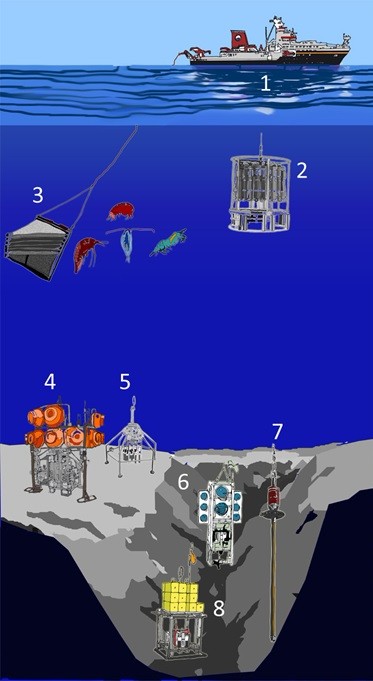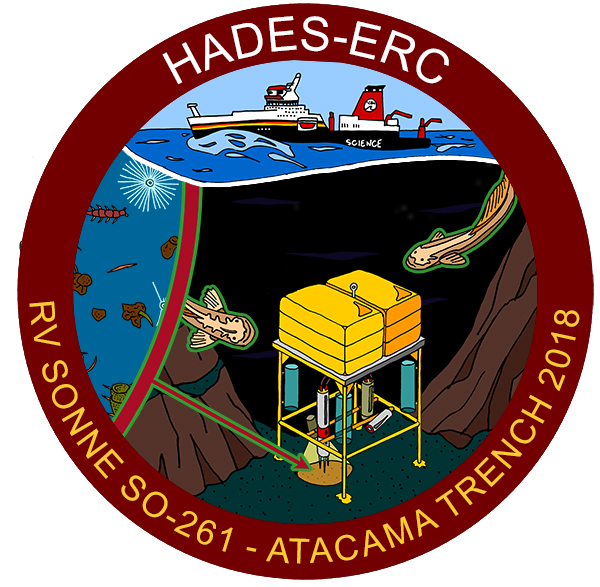- Presse
- Blogs und Meer
- Scientists are returning from the Atacama Trench - Blogpost 9 from RV SONNE
Scientists are returning from the Atacama Trench in the East Pacific Ocean - Blogpost 9 from RV SONNE, April 2, 2018
Guayaquil, April 2, 2018
Uncovering the secrets of the deep-sea ecosystem.

CTD-watersampler (2), MOCNESS for sampling plankton from different depths (3), deep-sea profiling lander (4), Multicorer for sediment samples (5), Nano-Lander for hadal depths at more than 8000 meters (6), Gravity corer for long sediment cores (7), sediment lander for in-situ measurement of biological activity at hadal depths (8).
From March 2nd till April 2nd, an international team of researchers, led by Professor Ronnie N. Glud, University of Southern Denmark and Dr. Frank Wenzhöfer, Max Planck Institute for Marine Microbiology in Bremen, were on a 32-day cruise on the German research vessel Sonne to the Atacama Trench in the eastern Pacific Ocean. During their cruise they collected samples from the water column and sediments from the shoulder and the bottom of the 8066 meters deep-sea trench. They covered a transect of 450 kilometers length by sampling 10 sites. Scientists from 15 different nations with a broad expertise in different scientific fields joined forces to elucidate the biology, biogeography and transport processes of this uncharted ecosystem. Now they report some of their findings.
Biological hot spots
Ronnie Glud and Frank Wenzhöfer both agree that the expedition was a great success. Their goal is to understand the trench system in its whole. The scientists collected large amounts of samples from the seafloor and the water column. They charted the seafloor with bathymetry and recorded high-resolution videos and photos. From these data, they were able to identify fish species in several depths. Ronnie Glud says: “Looking at our results from all sites at the Atacama Trench, we find a very high biological activity in the trench. At the bottom it was much higher than on the shoulders. These trenches are indeed biological hot spots.”
Chief scientist Frank Wenzhöfer says: “On this expedition, we followed a holistic approach. To our knowledge this is the first such expedition to a deep-sea trench of this kind. Our scientific crew members are specialists on their fields: taxonomy, microbiology, molecular biology, biogeochemistry and oceanography. We wanted to find out how this deep-sea system works. Any life in this depth of more than 8000 meters has to be adapted to the high pressure and to find its niche. Our questions were: what are food sources for the communities and how is microbial cycling the elements?”
The food web of the trench: From the very small to the big sizes
The start of the food web is the action of photosynthetic organisms in the sunlit upper layer. These microscopic organisms are food for other species. As the coastal waters of Chile and Peru are influenced by supplies of cold nutrient rich water from the deep sea, the growth of the photosynthetic microorganisms should be boosted. As a consequence, the Atacama Trench should benefit from this material flow from above. The trench is assumed to contain large deposits of organic material, funneled down from trench slopes and overlying waters. In order to get the full picture, all processes involved have to be studied.
The different size scales observed by the scientists cover a range of more than 10 billion: From the microscopic scale with small virus particles (1/10 of a micrometer) to bacteria (micrometer), meiofauna (millimeter), macrofauna (centimeter), megafauna (meter) to transport processes across thousands of meters. On each of the 10 different sites in and close to the Atacama trench, they collected samples and measured the oxygen profiles in the water column and in the sediments. Oxygen is a very powerful agent used by microbes to gain energy from organic matter. The more active the microbes in the sediments, the earlier the oxygen is used up. This is demonstrated by a steep decline of the oxygen profiles.
Glud explains: “When comparing different sites at 8000 meters, the oxygen penetration depth and other parameters showed an unexpected high variation. That indicates a variation in biological activity and local variations in the delivery of organic matter. We speculate that two main processes are responsible for this pattern: It can either be a local variation in the biomass production in the upper part of the water column, or material transported from the shoulders of the trench by seismic activity.”
Specific questions addressed during this cruise are:
- What are the sedimentary processes providing food for the hadal community in the Atacama Trench?
- How do abundance, diversity and community structure of microorganisms, meio- and macrofauna in the Atacama Trench differ from those in less productive trenches and nearby abyssal and shelf sites?
- What are the general biogeochemical characteristics of the surface and deep sediment and water column in the eutrophic Atacama Trench?
- Which mineralization pathways are responsible for organic matter breakdown in the eutrophic Atacama Trench?
- How efficient are microbial communities operating at extreme hydrostatic pressures in mineralizing organic material as compared to their shallower counterparts? And to what extent do specialized, yet unknown extremophile microbial communities mediate these processes?
Further information
More details about the project from the University of Southern Denmark.
More pictures related to the project.
Ronnie N Glud at Danmarks Radio (in Danish)
RV SONNE is a modern German research vessel sailing mainly in the Pacific Ocean.
More information about the ship here.

